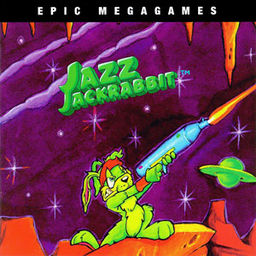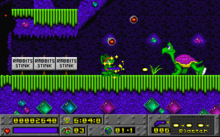- Jazz Jackrabbit (1994 video game)
-
Jazz Jackrabbit 
Game box art of the original 1994 releaseDeveloper(s) Epic Games, Arjan Brussee Publisher(s) Epic Games Designer(s) Cliff Bleszinski
Arjan BrusseePlatform(s) MS-DOS/Macintosh/Windows Release date(s) 30 July 1994 (original) Genre(s) Side-scrolling platform game, shoot 'em up Mode(s) Single player Media/distribution Floppy disk/CD-ROM System requirements 386 Computer (486 or higher recommended)
Jazz Jackrabbit is a platform game developed and published by Epic MegaGames. It was released in 1994 for PCs operating DOS, with subsequent Macintosh and Microsoft Windows releases in 1995 and 1996.
Jazz Jackrabbit was hugely inspired by the Amiga game Zool and such another ongoing success of console classics (such as Sonic the Hedgehog and Mega Man) defining the platform game genre in the 1990s market, and was initially considered to be a pastiche of Sega's Sonic the Hedgehog in the computer world. However, the game did not manage to reach as much popularity as to become PC's mascot, but did acquire a certain fan audience, especially due to its fast-paced gameplay, advanced graphics and notorious acid jazz level soundtracks.
In 1995, PC Format magazine named Jazz Jackrabbit "Arcade Game of the Year". Two other releases originated from it: a sequel named Jazz Jackrabbit 2 in 1998, as well as a reboot on Game Boy Advance in 2002.
Contents
Storyline
The game is set in a fantasy world based on Aesop's "The Tortoise and the Hare", in which the enmity between tortoises and hares continues even after three thousand years. An evil mastermind tortoise named Devan Shell begins conquering planets, suppressing any native confrontation. One of such planets, Carrotus, is home to a peaceful hare kingdom that, once confronted by Shell, is able to provide enough resistance to fend him off. Enraged by his loss, Devan decides to kidnap Carrotus princess Eva Earlong and hide her on a distant airbase of unknown location to weaken the hares. In response, the king chooses to send Carrotus' hero Jazz Jackrabbit, who carries a blue LFG-2000 gun, to various planets conquered by Devan that might contain clues to the location of Eva's imprisonment. As Jazz travels through different worlds, he gains new weapons and meets new enemies in his pursuit to rescue the princess and save Carrotus from Devan Shell and his army of Turtle Terrorists.
Jazz is depicted as a bright green jackrabbit with a red bandana, bracers and a blue "blaster" gun that he never loses the hold of.
Gameplay
The initial game is divided into six episodes (with three more episodes added subsequently; see releases section), each of which contains three planets (worlds), with every planet itself consisting of two levels (some planets have an additional secret level). The final level of every episode features a boss that the player must deal with in order to complete the level. Episodes are tied by a single storyline usually progressing after each episode is finished. Like in Jazz 2, levels' difficulty also progresses with every episode, however, unlike it, one does not have to play the previous episode before unlocking the next.
Gameplay mechanics in Jazz are very similar to Sonic the Hedgehog's, with the exception of not being able to destroy the enemies by simply jumping at them (which was not added until the second game). Jazz will run faster and jump higher the longer he runs, avoiding chasms that might lead to spikes or other unwanted objects. Unlike other arcade games, however, there are no abysses and every level bifurcates into subsections that might lead to valuable items (such as weapon pick-ups, score items, etc.) while the direction of general progression is hinted at with occasional arrows. Jazz has a life bar that changes in color based on how much health Jazz has remaining. Jazz can withstand a limited number of hits (5 on Easy mode, 4 on Medium mode, 3 on Hard or Turbo mode) from projectiles or spiked structures before losing a life; one hit's worth of health can be restored by picking up a carrot. Lives can also be accumulated to the maximum number of ten. When killed, Jazz can start further than the level beginning if a checkpoint sign was reached and activated (i.e. shot) before.
Items that the player can pick up usually resemble food, computer hardware components or other familiar shapes, and give 100 score points each. There are also several beneficial pick-ups in the game: a "force shield" that protects Jazz from one or four hits, a sidekick in form of a bird that shoots enemies, a hoverboard that allows to fly in the air, rapid fire/super jump bonuses, a temporary "speed-up" and invincibility, as well as extra lives. Weapons also vary in numbers and consistency and include (besides the initial blaster) bouncing launcher grenades, fireball flame thrower, bi-missile projectiles and TNT sets. Large sets of ammunition, permanent bonuses (with the exception of the hoverboard, rapid fire and super jump) and the speed-up cannot be picked up by moving Jazz over them, and must be shot from their enclosure to be activated.
Unlike its sequel, the first game features a timer that starts at roughly 10 minutes at the beginning of each level (on Easy mode; this decreases to 8 minutes on Medium, 6 minutes on Hard, and 4 minutes on Turbo) and counts down to zero; on Hard and Turbo, another countdown appears at the top of the screen when there is less than a minute left, and if time expires, Jazz dies. If Jazz reaches and shoots the finish sign before time runs out, the player is then provided with additional score points that can furthermore lead to granting entry into a bonus stage, if coupled with 100% level completion (that occurs when all the items and weapons are picked, and all the enemies dealt with). In theses stages, animation switches to a pseudo-3D (third-person shooter) of Jazz as he runs on a speedway with the purpose of gathering as many blue diamonds as requested before time runs out, while other doodads try to stop him or slow him down. If the task is accomplished successfully, the player is provided with an extra life. Another way to reach bonus stages is to find a big red diamond and "take" it.
Aside from bonuses, Jazz also features secret levels that can be accessed in specific areas of other levels once in every episode. Secret level signs feature the question mark instead of Devan's head portrait that must be shot. The current level is then considered completed and the secret level embarks. Levels themselves consist of an enormous "grant" area with numerous weapons and items to pick up. One level, however, features a mini-boss, while the player assumes control of Jazz in his sidekick bird form. Secret levels also feature a count-up upon completion that provides the player with extra score points. In the C-episode there is a secret level with Jazz in the form of a lizard.
Release chronology
- July 30, 1994: the original game first official release on three floppy diskettes, featuring MS-DOS support only. The soundtrack was recorded for Adlib, Gravis Ultrasound and Soundblaster playback. The episodes were unlockable by pairs of three (i.e. the first or the last three) with a special code that was given over the phone during the purchase. However, due to considerable increase in game pirating, the code purchase was later dropped for the original six episodes in one pack release.
- August–September 1994: a shareware version of the first release was made and included as a promo with other Epic's titles. It contains the first episode (with six original and one secret levels) plus three bonus levels.
- December 1994: the Xmas Edition (also known as the Christmas Edition in Europe) diskette update, which includes all of the original levels plus an extra episode called "Holidaius" that features seven levels and two bonus levels. The installation required the original game to be installed and was a simple update of its files.
- April 1995: Macintosh diskette release (for System 7.5), full original version. It is the only original Jazz released for Mac.
- May–June 1995: First CD-ROM release. Among the features, an easter egg was added in which the game would unlock "Holidaius" upon being run with the computer BIOS clock set between November 30 and January 1.
- December 1995: Holiday Hare release on CD-ROM, which is an updated version of the Xmas Edition. Unlike its previous add-on, however, the release includes all of the original content and support plus first episode levels taken from the shareware and redesigned to feature Christmas-themed content. The release is also standalone, unlike its predecessor.
- Spring 1996: the shareware version of Holiday Hare is released for MS-DOS 7.
- August 1996: CD-ROM release of the original game for Windows 95. Last official release. This version was also often included in the later Jazz Jackrabbit 2 releases as a bonus.
Game tools and level editors
OpenJazz is a game engine recreation for Jazz Jackrabbit created by Alister Thomson. Work was started on August 23, 2005, made public on November 28 of the same year, and had its source code released on Christmas Day. It is available for Linux and Microsoft Windows; there are also ports to the Dreamcast, GP32, GP2X, WIZ, Dingoo A320, Open Pandora, Wii, PlayStation Portable and Windows Mobile based pocket PC/PDA devices.
JCS'94 is a Level editor for Jazz Jackrabbit. It was started more than two years before the OpenJazz project. Its latest proposed release date was November 2005.[citation needed] The makers of JCS'94 helped resolve some issues in the development of OpenJazz.
J1E is another Level editor for Jazz Jackrabbit. It was started as a more feature complete alternative to JCS'94. It contains features lacking from JCS'94, including editing possibilities for movements, animations and attacks. This editor is criticized because of its lack of documentation. J1E was written in Java and requires a JVM. It has been tested on Microsoft Windows.
Trivia
The character Zool which this game is based on makes a cameo as a boss called Zoonik (with purple spiky hair, green overalls, a purple body, and a fox tail) and uses a laser gun as a weapon.
External links
- Jazz 2 Online (J2O), the hub of the Jazz Jackrabbit community
- JazzJackrabbit Community Forums (JCF), the message board associated with Jazz 2 Online
- Earlong Royal Encyclopedia (ERE), the wiki associated with Jazz 2 Online
- Haze's Hideout JJ1 page
- DOS Games Archive | Jazz Jackrabbit
- OpenJazz JCF thread
- Jazz Jackrabbit at MobyGames
Jazz Jackrabbit series Jazz Jackrabbit • Jazz Jackrabbit 2 • Jazz Jackrabbit 3 • Jazz Jackrabbit (2002)Epic Games Subsidiaries Games developed Jazz Jackrabbit · 2OtherBulletstorm · Epic Pinball · Extreme Pinball · Infinity Blade · Jill of the Jungle · Kiloblaster · Shadow Complex · Silverball · Solar Winds · Super ZZT · Xargon · ZZTGames published The Adventures of Robbo · Age of Wonders · Ancients 1: Deathwatch · Brix · Castle of the Winds · Dare to Dream · Electro Man · Heartlight · Highway Hunter · Ken's Labyrinth · One Must Fall: 2097 · Seek and Destroy · Traffic Department 2192 · Tyrian · Zone 66People Technology Miscellaneous Infinity Blade: AwakeningCategories:- 1994 video games
- Epic Games games
- Cancelled PlayStation games
- Cancelled Sega Saturn games
- Cancelled Super Nintendo Entertainment System games
- Cancelled Nintendo Entertainment System games
- Cancelled Sega Mega Drive games
- Cancelled Game Gear games
- Cancelled Master System games
- Cancelled Game Boy games
- DOS games
- Jazz Jackrabbit games
- Run and gun games
- Comedy video games
- Video games developed in the Netherlands
- Video games developed in the United States
- Video games featuring anthropomorphic characters
Wikimedia Foundation. 2010.


